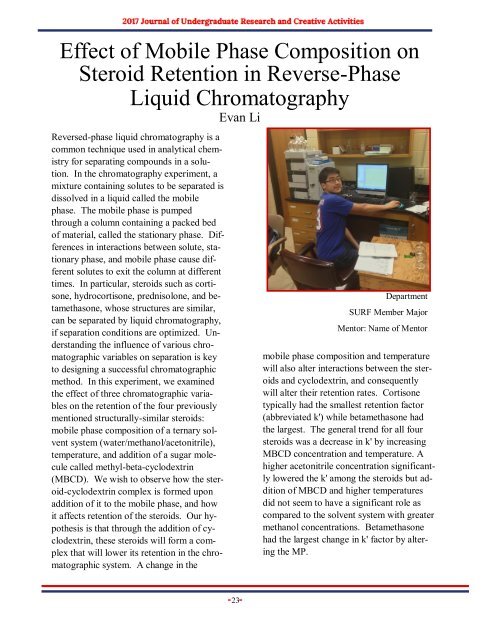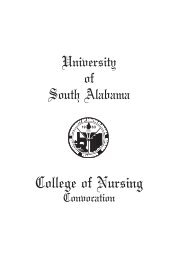JOURACA_SP_2017
Create successful ePaper yourself
Turn your PDF publications into a flip-book with our unique Google optimized e-Paper software.
Effect of Mobile Phase Composition on<br />
Steroid Retention in Reverse-Phase<br />
Liquid Chromatography<br />
Evan Li<br />
Reversed-phase liquid chromatography is a<br />
common technique used in analytical chemistry<br />
for separating compounds in a solution.<br />
In the chromatography experiment, a<br />
mixture containing solutes to be separated is<br />
dissolved in a liquid called the mobile<br />
phase. The mobile phase is pumped<br />
through a column containing a packed bed<br />
of material, called the stationary phase. Differences<br />
in interactions between solute, stationary<br />
phase, and mobile phase cause different<br />
solutes to exit the column at different<br />
times. In particular, steroids such as cortisone,<br />
hydrocortisone, prednisolone, and betamethasone,<br />
whose structures are similar,<br />
can be separated by liquid chromatography,<br />
if separation conditions are optimized. Understanding<br />
the influence of various chromatographic<br />
variables on separation is key<br />
to designing a successful chromatographic<br />
method. In this experiment, we examined<br />
the effect of three chromatographic variables<br />
on the retention of the four previously<br />
mentioned structurally-similar steroids:<br />
mobile phase composition of a ternary solvent<br />
system (water/methanol/acetonitrile),<br />
temperature, and addition of a sugar molecule<br />
called methyl-beta-cyclodextrin<br />
(MBCD). We wish to observe how the steroid-cyclodextrin<br />
complex is formed upon<br />
addition of it to the mobile phase, and how<br />
it affects retention of the steroids. Our hypothesis<br />
is that through the addition of cyclodextrin,<br />
these steroids will form a complex<br />
that will lower its retention in the chromatographic<br />
system. A change in the<br />
Department<br />
SURF Member Major<br />
Mentor: Name of Mentor<br />
mobile phase composition and temperature<br />
will also alter interactions between the steroids<br />
and cyclodextrin, and consequently<br />
will alter their retention rates. Cortisone<br />
typically had the smallest retention factor<br />
(abbreviated k') while betamethasone had<br />
the largest. The general trend for all four<br />
steroids was a decrease in k' by increasing<br />
MBCD concentration and temperature. A<br />
higher acetonitrile concentration significantly<br />
lowered the k' among the steroids but addition<br />
of MBCD and higher temperatures<br />
did not seem to have a significant role as<br />
compared to the solvent system with greater<br />
methanol concentrations. Betamethasone<br />
had the largest change in k' factor by altering<br />
the MP.<br />
23

















